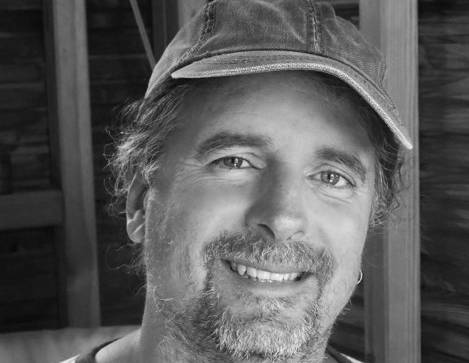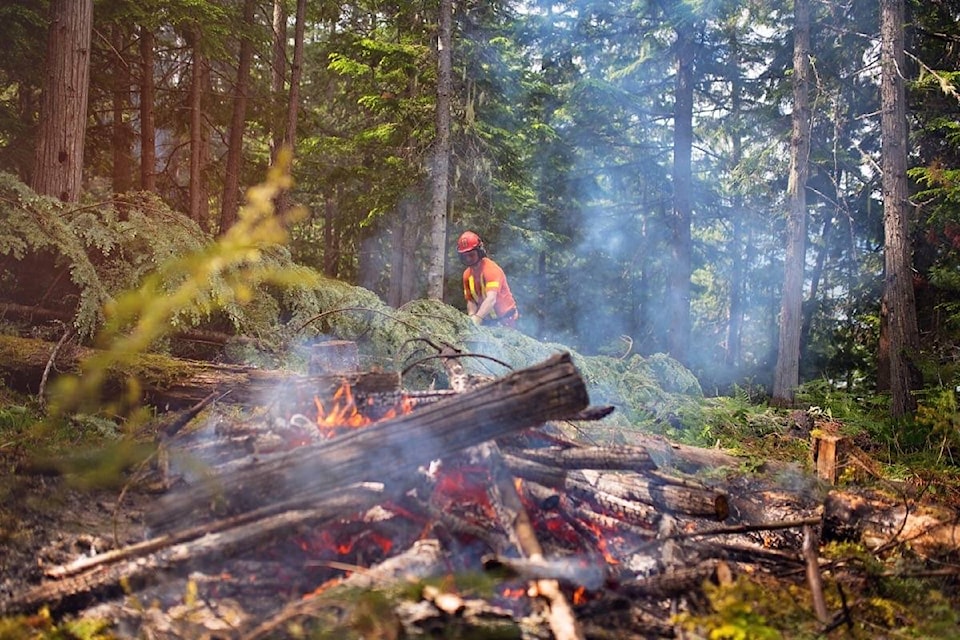This spring on a south facing 60 hectare slope covered with ponderosa pine forest, Stephan Martineau and his colleagues at the Slocan Integral Forestry Collective (SIFCo) in collaboration with the BC Wildfire Services, started a forest fire.
It was intentional. Their research had told them that slope was a very likely path for a wildfire to take, so they wanted to get there first, but in a controlled way.
“There has not been fire there since we began suppressing them,” Martineau says, “so there is ingrowth of a lot of smaller trees. Imagine large ponderosa pines with extreme ingrowing — it creates ladder fuels, so the fire intensity and spread would be extreme.”
So the crew went in and cut out much of the smaller growth by hand, the year before the burn, to the point where they felt they could safely create a controlled burn. It was labour intensive.
“We raked every ponderosa pine at the base to make sure accumulations of needles from the past fifty years were not there, so the fire would go around the tree instead of going up it.”
The burn, conducted by the BC Wildfire Service, was successful and now, if a wildfire burns through that area, Martineau says, “the intensity would be dramatically reduced and give us the opportunity to defend ourselves. The potential of a landscape-sized fire is now reduced to a ground fire that is defendable if it was to happen.”
Martineau uses the word “landscape” a lot, and he’ll be doing that in his presentation at the Wildfire and Climate Change in the Kootenays conference in Nelson on June 26 to 28.
Landscapes and ecosystems are the focus
The conference is subtitled Ecosystem Resiliency, Community Protection and Landscape Level Management. It features a large array of local and international speakers from government, business, and academia.
That variety of perspectives is the point of the conference, Martineau says.
To deal with fire danger across an entire landscape, he says, you have to get everyone involved. That includes timber companies, private landowners, other residents, regional and municipal governments, the BC Wildfire Service, the Ministry of Forests and other provincial agencies, along with academics who study climate change, wildfire, and emergency preparedness.
“We often work in silos and we need to break out of our silos and talk about how we can synergize and be more effective,” says Martineau.
Changes coming much too fast
Martineau considers SIFCo to be a leader in landscape level fire prevention and ecosystem based forest management, having treated close to 600 ha of land in the Slocan Valley in the last ten years and with plans for another 1,000 ha over the next five years.
The group has a strategic wildfire plan for the valley and is in the process of creating 12 landscape sized fuel breaks using a number of site-specific methods ranging from thinning to logging to prescribed burns.
“The idea is to create large scale fuel breaks – we are not talking about a bare landscape, that is often the image people have. We are talking about leaving a forest behind that is more resilient to climate change and to fire.”
But he says it’s not enough.
“We need to look at ways that we can scale the things we are doing, because the pace we are moving is way too slow for the challenges that are coming our way much too fast. The good things we have been doing regionally and provincially need to be multiplied by 100.”
SIFCo has been working on its own community forest tenure and with local municipalities, but that’s a small percentage of the forest land in the Slocan Valley. Much of it is crown land licensed by the province to other forest companies, and Martineau says they need to be more involved and government incentives will be needed to encourage that.
Private land is the elephant in the room
About 40 per cent of the land located within the 12 landscape level fuel breaks that SIFCo is creating in the Slocan Valley is privately owned, according to Martineau. It’s expensive and complicated for an owner of forest land to do the kinds of fuel treatment SIFCo specializes in. He thinks the provincial government should create incentives for private landowners.
“If someone with a 40 acre piece of property (carried out fuel treatment), that could save an entire village. (Private forest land) is often the elephant in the room, historically. We say we don’t want to fund things on private land, but wildfire does not stop at the property line.”
He says the conference is offering a lower registration fee for local residents “because we want them to be there and want them to be part of the solution.”
Martineau says landscape level management may be expensive but we have to keep that in perspective. He says SIFCo has spent about $4 million on fuel treatment over the years so far.
“But the Springer Creek fire (near Slocan) in 2007 cost $11 million to fight. So if all the work we have done avoids one of those fires, it is a good investment for the province.”
Wildfire and Climate Change in the Kootenays is a project of SIFCo and the Ministry of Forests, Lands, Natural Resource Operations and Rural Development.
Related stories in the Nelson Star:
• Action by Nelson area landowners key to wildfire safety, expert says (June 2016)
• Fire experts: Nelson could burn (Dec, 2016)
• RDCK plans wildfire fuel action (Aug. 2017)
• West Arm Park fire prevention plans move forward (Oct. 2017)
• Column: Will West Kootenay forests survive? (Nov. 2017)
• Fighting fire with fire (Nov. 2017)
• Wildfire fuel treatment expands in Nelson area (June 2018)
bill.metcalfe@nelsonstar.com
Like us on Facebook and follow us on Twitter

